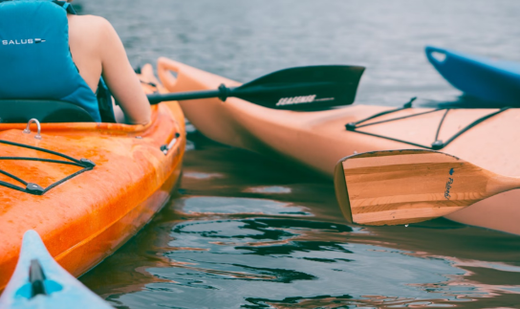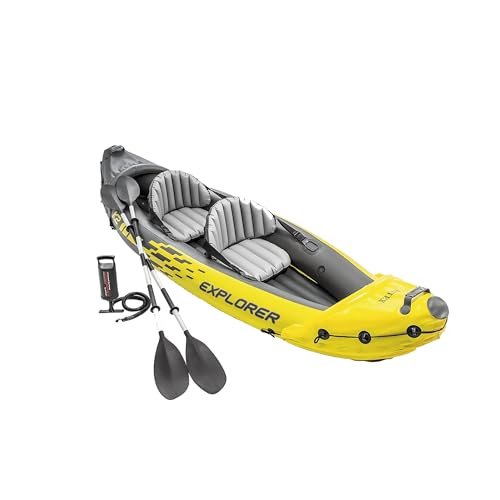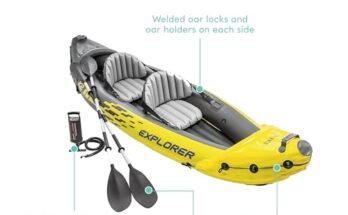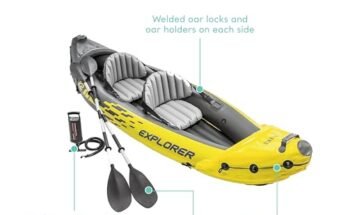Are you wondering whether to choose a canoe or a kayak for your next water adventure? Knowing when to use a canoe versus a kayak can make all the difference in how much fun you have on the water.
Both offer unique benefits, but picking the right one depends on your plans, skill level, and the type of water you’ll be exploring. Keep reading, and you’ll discover clear answers that help you make the best choice—so your next trip is smooth, safe, and unforgettable.
Canoe Basics
Canoes are simple boats designed for calm and slow waters. They have been used for centuries by many cultures around the world. Knowing the basics helps you choose between a canoe and a kayak.
This guide covers canoe design, common uses, and key advantages. It will help you understand when to use a canoe instead of a kayak.
Design And Structure
Canoes are open on top and usually have a wider body than kayaks. They often have bench seats or no seats at all. This design makes them stable and easy to enter and exit.
| Feature | Canoe | Kayak |
| Shape | Open, wide body | Closed cockpit, narrow body |
| Seats | Benches or open floor | Low seats with footrests |
| Paddle | Single-bladed | Double-bladed |
| Material | Wood, aluminum, plastic | Plastic, fiberglass, carbon fiber |
Common Uses
- Family trips on lakes and calm rivers
- Fishing because of the stable platform
- Carrying more gear or passengers
- Camping trips where space is needed
- Recreational paddling with easy access in and out
Canoes are less suited for fast water or whitewater conditions. They work best where stability and space matter.
Advantages
Canoes offer several benefits compared to kayaks. They provide room for more people and equipment. The open design lets you move around easily.
- More stable on calm water
- Easy to get in and out
- Better for carrying large or bulky items
- Good for beginners and families
- Allows standing in shallow water

Kayak Essentials
Choosing between a canoe and a kayak depends on your needs. Kayaks have unique features that suit many water activities.
This guide covers the design, uses, and benefits of kayaks to help you decide when to use them.
Design And Structure
Kayaks have a closed deck with a cockpit for the paddler. They are usually narrower than canoes. This design helps kayaks move faster in water.
Most kayaks have double-bladed paddles. The paddler sits low with legs extended inside the hull. This position gives better control and balance.
Common Uses
- Recreational paddling on lakes and calm rivers
- Whitewater kayaking for rough river rapids
- Sea kayaking along coastlines and open water
- Fishing from a stable kayak platform
- Touring for long-distance trips on various water bodies
Advantages
| Feature | Benefit |
| Narrow hull | Increases speed and efficiency in water |
| Closed deck | Keeps paddler dry and protects from splashes |
| Low seating position | Improves stability and control |
| Double-bladed paddle | Offers balanced and powerful strokes |
| Lightweight design | Easy to carry and maneuver |
Comparing Canoes And Kayaks
Canoes and kayaks are both popular boats for water activities. They look similar but have key differences. Knowing these can help you pick the right one.
This guide compares canoes and kayaks on stability, speed, storage, and comfort. It helps you decide which suits your needs best.
Stability And Balance
Canoes usually have a wider base. This makes them more stable on calm water. Beginners often find canoes easier to balance.
Kayaks have a narrower shape. This can feel less stable at first. They require better balance but handle rough water well.
- Canoes: Wide base, good for calm lakes
- Kayaks: Narrow base, better for waves and rapids
Speed And Maneuverability
Kayaks are faster and easier to steer. Their shape helps them cut through water quickly. They work well for rivers and open water.
Canoes are slower but hold a straight course easily. They need more effort to turn. Canoes suit relaxed paddling and calm waters.
- Kayaks: Fast, agile, great for quick turns
- Canoes: Slower, steady, better for long straight trips
Capacity And Storage
Canoes offer more space for people and gear. You can carry several passengers and camping equipment. This makes them ideal for group trips.
Kayaks fit one or two people. They have limited storage space. Most gear must fit in small compartments or on deck.
- Canoes: Large capacity, good for groups and gear
- Kayaks: Smaller capacity, limited storage space
Comfort And Seating
Canoes have open seating with benches. This allows easy movement and changing positions. Paddlers sit higher and can stretch out more.
Kayaks have enclosed cockpits. Paddlers sit low with legs extended. Seats have back support but limit movement more than canoes.
- Canoes: Open benches, more legroom, flexible seating
- Kayaks: Enclosed seats, better back support, less space
Choosing Based On Water Type
Deciding between a canoe and a kayak depends on the water. Each has strengths suited to different environments.
Let’s explore how to choose the right vessel for various types of water.
Calm Lakes And Ponds
On calm lakes and ponds, both canoes and kayaks work well. The choice depends on your preferences for stability and ease of use.
- Canoes offer more space for gear and passengers.
- Kayaks are easier to paddle alone and faster.
- Consider the weather and your experience level.
Rivers And Rapids
Rivers and rapids require boats that handle swift currents. Kayaks are often preferred for their agility and control.
| Water Condition | Recommended Vessel |
| Slow River | Canoe or Kayak |
| Fast Rapids | Kayak |
| Shallow Waters | Canoe |
Ocean And Coastal Waters
In ocean and coastal waters, kayaks are usually the better choice. They are designed to handle waves and currents effectively.
Skill Level Considerations
Choosing between a canoe and a kayak depends a lot on your skill level. Both have their benefits and challenges. Understanding your experience helps you pick the right boat.
This guide looks at beginner friendly options, advanced techniques, and safety tips. It helps you decide which craft fits your skills best.
Beginner Friendly Options
Canoes and kayaks both have beginner models. Canoes are stable and easy to balance. Kayaks are smaller and easier to steer. Beginners should consider stability and control.
- Canoes offer wider seats and more space to move.
- Kayaks are lighter and easier to carry.
- Flat water is ideal for beginners in either craft.
- Choose a boat with good stability for first trips.
Advanced Techniques
Advanced paddlers use canoes and kayaks differently. Canoeists often paddle kneeling for power. Kayakers use strokes like the sweep and draw to turn quickly.
| Technique | Canoe | Kayak |
| Turning | J-stroke | Sweep stroke |
| Speed | Kneeling paddle stroke | High-angle paddle stroke |
| Balance | Kneeling position | Edge control |
Safety Tips
Safety is key for all skill levels. Wearing a life jacket is a must. Weather and water conditions affect your safety. Knowing your limits prevents accidents.
- Always wear a personal flotation device
- Check weather before you go
- Carry a whistle or signaling device
- Practice self-rescue techniques
- Inform someone about your trip plan

Activity-specific Choices
Choosing between a canoe and a kayak depends on the activity you plan to do. Each offers unique benefits for different experiences on the water.
Consider factors like stability, speed, and storage when deciding which to use. Let’s explore which watercraft fits best for specific activities.
Fishing
Canoes provide more space and stability, making them ideal for fishing trips. You can easily move around and access your gear.
Kayaks are more agile and can reach tighter spots in the water. They are better for solo fishing adventures.
- Canoes: More room for gear and extra anglers
- Kayaks: Easier to maneuver in narrow areas
Recreational Paddling
For leisurely paddling, both canoes and kayaks offer fun experiences. Canoes are often more stable, great for families and groups.
Kayaks, being more streamlined, provide a faster ride. They are perfect for those who enjoy a bit more speed.
- Canoes: Stable and spacious for group outings
- Kayaks: Faster and more exciting for solo paddlers
Camping And Touring
Canoes can carry more supplies, making them ideal for longer trips. They allow you to pack tents and food easily.
Kayaks are better for short touring trips, offering speed and efficiency. They are suited for quick overnight adventures.
- Canoes: More storage for extended camping trips
- Kayaks: Speedy for short, quick tours
Gear And Equipment Differences
Canoes and kayaks use different gear that suits their shape and use. Choosing the right gear helps you paddle better and stay safe.
This guide covers paddles, safety gear, and storage solutions for each boat type.
Paddles
Canoe paddles have one blade and a long handle. Kayak paddles have two blades and a shorter shaft. The paddle style affects how you control the boat.
- Canoe Paddles:Single blade, used on one side at a time.
- Kayak Paddles:Double blade, alternate sides quickly.
- Material:Both can be wood, aluminum, or carbon fiber.
- Length:Canoe paddles are longer to reach the water from a higher seat.
- Shape:Kayak paddles are narrower to reduce water resistance.
Safety Gear
Safety gear is important for both types but varies slightly. Each boat needs life jackets and helmets for rough waters. Canoes may need extra flotation bags due to their open design.
| Safety Gear | Canoe | Kayak |
| Life Jacket | Required for all riders | Required for all riders |
| Helmet | Needed in whitewater or rocky areas | Needed in whitewater or rocky areas |
| Flotation Bags | Common to add for extra buoyancy | Rarely needed due to sealed cockpit |
| Whistle | Recommended for emergency signaling | Recommended for emergency signaling |
Storage Solutions
Canoes have open space that allows flexible storage but exposes gear to water. Kayaks use sealed compartments to keep items dry and secure.
Storage tips for each boat type:
- Canoe:Use waterproof bags to protect gear.
- Kayak:Pack gear inside hatches and use dry bags for extra protection.
- Both:Secure gear to prevent shifting while paddling.

Budget And Maintenance
Choosing between a canoe and a kayak affects your budget and maintenance efforts. Both have different costs and upkeep needs.
Understanding these differences helps you decide which fits your lifestyle and wallet better.
Initial Costs
Canoes often cost more upfront due to their larger size and materials. Kayaks usually have a lower starting price. Accessories also add to the cost.
- Canoe price range: $500 to $2000
- Kayak price range: $300 to $1500
- Essential gear: paddles, life vests, and storage bags
- Extra costs: transport racks and safety equipment
Upkeep And Repairs
Both boats need regular care. Canoes may require more space for storage and can be harder to repair due to size. Kayaks are easier to maintain but can suffer from hull damage.
| Maintenance Task | Canoe | Kayak |
| Cleaning | Wash after use | Wash after use |
| Storage | Needs large, dry space | Easier to store indoors |
| Repairs | May require professional help | Minor repairs can be DIY |
| Regular Checks | Inspect for cracks and leaks | Check hull and fittings |
Longevity
How long a boat lasts depends on material and care. Both can last many years if stored and maintained well.
- Canoes made from aluminum or fiberglass last longer
- Plastic kayaks are durable but may fade in sunlight
- Avoid dragging boats on rough surfaces
- Regular maintenance extends life span
Frequently Asked Questions
When Should I Choose A Canoe Over A Kayak?
Choose a canoe for calm waters, carrying gear, or group paddling. Canoes offer more space and stability. They are ideal for lakes, slow rivers, and family trips. Kayaks suit faster waters and solo adventures better.
What Are The Main Differences Between Canoe And Kayak?
Canoes have open tops and use single-bladed paddles. Kayaks have closed decks and use double-bladed paddles. Canoes offer more storage and seating space. Kayaks are faster and better for rough waters.
Is A Kayak Better For Whitewater Or Ocean Paddling?
Yes, kayaks are better for whitewater and ocean paddling. Their design offers better control, speed, and maneuverability in rough conditions. Canoes are less stable in fast currents and waves.
Can Beginners Use Canoes Or Kayaks More Easily?
Beginners often find canoes easier to balance and paddle slowly. Kayaks require more skill to control but offer better speed. Both can be beginner-friendly with proper instruction and calm waters.
Conclusion
Choosing between a canoe and a kayak depends on your plans and water type. Canoes suit calm lakes and carrying gear. Kayaks work well in fast rivers and rough waters. Both offer fun and exercise outdoors. Think about comfort, space, and ease of use.
Try both if you can. Enjoy your time on the water safely and happily.



